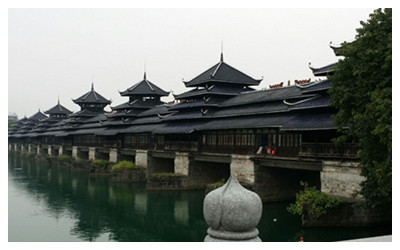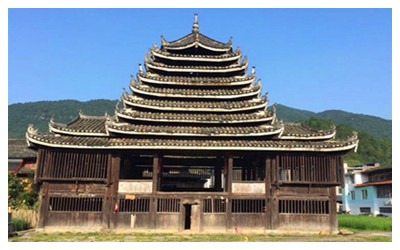
Wind-and-Rain Bridge and Drum Tower
The Wind-and-Rain Bridge in Dong Village
 The gate to a Dong village features a unique architectural style. It has a wooden structure, constructed with mortise and tenon joints, so that not a single nail is used. Every Dong village has a gate where locals welcome and see off visitors and guests. According to the local custom, all visitors or guests are presented with a bowl of wine before entering the gate. Those who receive wine from a girl, singing in an antiphonal style, must return her greeting in song. Those who cannot sing, or who fail to respond, are obliged to drink more wine. It is only after drinking that visitors qualify to become good friends of the Dong people. Within the local customs, visitors should present a gift of sentimental value to the girls who give them wine, to express their sincere thanks, and as a memento of the occasion.
The gate to a Dong village features a unique architectural style. It has a wooden structure, constructed with mortise and tenon joints, so that not a single nail is used. Every Dong village has a gate where locals welcome and see off visitors and guests. According to the local custom, all visitors or guests are presented with a bowl of wine before entering the gate. Those who receive wine from a girl, singing in an antiphonal style, must return her greeting in song. Those who cannot sing, or who fail to respond, are obliged to drink more wine. It is only after drinking that visitors qualify to become good friends of the Dong people. Within the local customs, visitors should present a gift of sentimental value to the girls who give them wine, to express their sincere thanks, and as a memento of the occasion.
The Wind-and-Rain Bridge in the Dong village we visited was constructed during the reign of Qing Emperor Jiaqing. It displays a skillful combination of the railing-style structure popular in Dong villages, and the Han Chinese architectural style of bridge construction. It has a wooden corridor, three pavilion-style pagodas, under which stand three halls housing the local gods. On the pinnacle of the highest pagoda are four dragons which guard its inner treasures, signifying that the Dong village is well protected by its surrounding mountains.
Dong villages are usually constructed either on mountain slopes or on flatland. Four of the Dong villages in Huangdu Township are built on mountain slopes with a stream nearby. A legend says that during the reign of Ming Emperor Yongle, four brothers settled in the area as it is surrounded by mountains on four sides. The mountains resembled four great dragons guarding treasure. So, over time, the four brothers built four villages, naming them Dragon-head Village, Dragon-tail Village, Spiraling Dragon Village and New Village.
Drum towers in Dong Village
 Drum towers are the hallmarks of Dong villages. A drum tower consists of either three or five stories, the tallest being over a dozen stories. The ground floor is square, and from the uppermost point hangs a huge hide drum, hence, its name. The drum tower is regarded as the headquarters of a Dong village, a place where meetings are held, village matters are discussed, and mediation on disputes among villagers takes place. It is also an ideal place for villagers to gather when the season of hard labor ends, and for their recreational pursuits of pipa playing, story telling and singing. On festive occasions, it is also the place where guests are welcomed and seen off, where contests in antiphonal singing and reed-pipe wind instrument playing are staged, and where the lion and dragon dances are held. The two drum towers we visited in Huangtu Township were also built on mountain slopes.
Drum towers are the hallmarks of Dong villages. A drum tower consists of either three or five stories, the tallest being over a dozen stories. The ground floor is square, and from the uppermost point hangs a huge hide drum, hence, its name. The drum tower is regarded as the headquarters of a Dong village, a place where meetings are held, village matters are discussed, and mediation on disputes among villagers takes place. It is also an ideal place for villagers to gather when the season of hard labor ends, and for their recreational pursuits of pipa playing, story telling and singing. On festive occasions, it is also the place where guests are welcomed and seen off, where contests in antiphonal singing and reed-pipe wind instrument playing are staged, and where the lion and dragon dances are held. The two drum towers we visited in Huangtu Township were also built on mountain slopes.
Dong villagers live in pile dwellings. These unique buildings are stable, durable and effective in preventing any possible occasional attacks of wild animals and reptiles, and feature spacious first floors. Apart from the roof tiles, the three-story wooden structure dwellings are crafted entirely using mortise and tenon joints. On the first floor, domestic fowls and draught animals are housed; the central room on the second floor is a sitting room where the family members retire to cool off in summer, and where the women do household chores and the girls weave. To the right is the kitchen, and to the left, the bedroom of the older family members. On the third floor are bedrooms for the younger family members, which is also used to store grain. There is generally one family to a building, although nowadays, it is also quite common for several buildings to be linked up by corridors.



 Ask Questions ?
Ask Questions ?